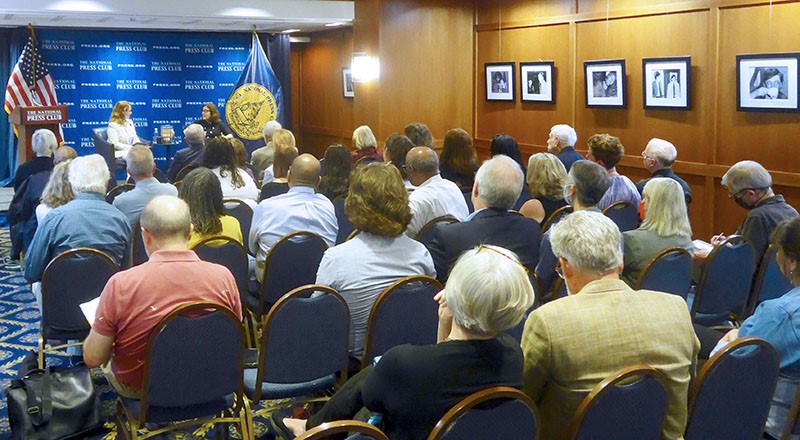Author reports implicit bias in Shaker Heights school despite citizens' efforts
Growing up in Shaker Heights, Ohio, a city uniquely devoted to racial equity since the 1950s, Laura Meckler felt enormous pride. She used to say, “You guys have racial problems, but we’ve got this figured out,” she explained at a National Press Club Headliners’ book event Sept.13.
As national education writer for the Washington Post, however, Meckler learned that the truth was far more complex, a discovery that set her on the path to write her new book, "Dream Town: Shaker Heights and the Quest for Racial Equity."
In her book, Meckler explored time-honored myths versus uncomfortable truths, the shifting definitions of success and failure in racial equity, and the perplexing question of why the racial achievement gap in Shaker Heights schools—including those she attended in the 1990s—still exists after decades of efforts to eradicate it.
She provided the history of Shaker Heights that was developed at the turn of the twentieth century as a suburb of Cleveland, an elite enclave for wealthy whites escaping the busy city for big lawns, rolling hills, and life in a parklike setting. Covenants were designed to allow only the “right sort of people” in, excluding Catholics, Jews, and Blacks. But somehow Catholics and Jews slipped in, while the “wrong sort,” Blacks, did not.
She explained that caught up in the racial justice movement of the 1950s, citizens came together with the goal of making their city an integration pioneer. This resulted in white flight and banks refusing to lend to Black home buyers. The city persevered, however, with an ambitious school busing program in the 1960s, and by the 1970s Shaker Heights was the crown jewel of successful integration in the United States. Today the city of some 30,000 boasts public schools with a student population almost equally Black and white, as well as great economic diversity, an unusual suburban characteristic.
To research her book, Meckler conducted more than 250 interviews, read thousands of documents, and spent several days as “a fly on the wall” in the school of an accommodating high school principal. She described Dream Town as “character driven,” diving into the personal stories of Black and white students, their families and faculty alike.
She reported incidents of implicit bias in the school that imbues Black students with self-doubt and a strong sense of not belonging in the more advanced classes, which creates a continuing cycle of lower achievement levels.
Meckler told the tale of a Black teenager who signed up for an elective summer typing class. A white assistant principal saw him in the hall and, assuming he was a bad student, gave him a pep talk about how summer school would improve his grades—which were fine, thank you very much.
She spoke of another Black student who walked into an AP class on the first day of school only to be asked by the teacher, “Are you sure you’ve got the right place?”

And she described a startled Black teen who, upon entering her 11th grade AP English class the first day of school, saw a sea of White faces staring at her. That day the student asked her counselor to transfer her to the lower-level honors English as she felt that she didn’t belong in the more advanced class, that she would be lonely there and the counselor agreed.
“The system is wrong when the girl walks into a room and feels immediately that she doesn’t belong”, Meckler said. “And it’s wrong that her counselor automatically agreed to put her in the other class. She should have encouraged her to stay and promised her support. It’s probably not intentional, but implicit bias was there. I struggled in AP calculus but never for a moment did I feel I didn’t belong.”
Meckler pointed out that the city’s economic divide also adversely affects the racial achievement gap in schools. In 1989, the city’s Black income was 65% of Whites. By 2020, it had dropped to 35%. Black poverty rose from 4.5% to 15%, while white poverty remained stable at 3%.
Wealthier, mostly white parents send their kids to science camps in summer, attend teacher meetings, and help their kids with algebra. Many lower-income parents don’t have cars, or they work three jobs and struggle just to get their children to school; they don’t have time to meet with teachers and don’t know algebra, the author said.
As a white student in the local high school, Meckler was blissfully unaware of these issues, she said.
What’s the solution? Meckler’s former school superintendent told her, “Eradicate poverty and eliminate racism.”
The author said that Important questions about the Shaker Heights experiment remain unanswered. Has the city succeeded in providing some measure of racial equity? Or is it a failure despite its seventy years of striving? “It’s not a thirty-day juice cleanse,” Meckler stated. “It’s a long-term commitment of many decades.”
In the end, Meckler is still proud of her hometown and her high school. “I came away hopeful,” she said. “In our country, very few places are even trying. The fact that they are still working at it is a success even if they haven’t fully achieved it.”
